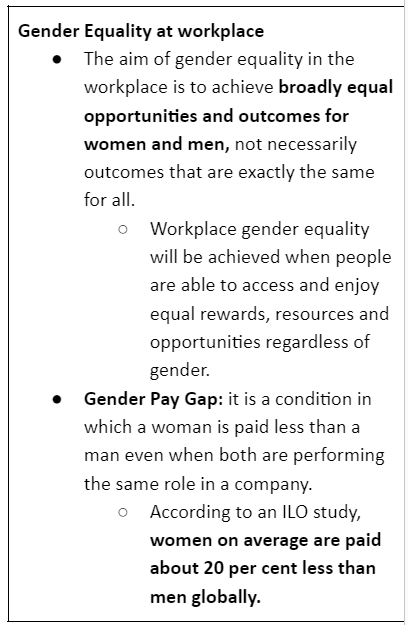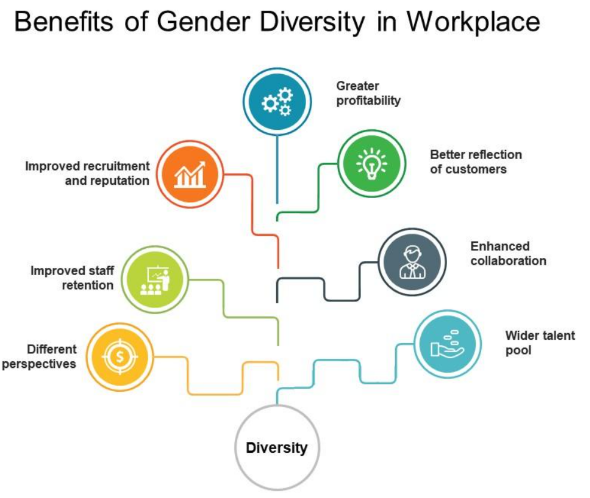
Context:
Recent research from various agencies such as S&P global found that in India’s 50 largest firms, two-thirds have fewer than 20% women employees.
More on the News
- Lack of Diversity: Research on Diversity, Equity, and Inclusion in the Indian context reveals that male employees represent 78%, female employees represent 18% and transgender employees represent only 4% of the working population in India.
- Gender Bias: According to Confederation of Indian Industry (CII), women hold only 14% of the top executive positions in India’s Top 500 companies by market capitalisation.
- Male Skewed: Corporate landscape in India remains skewed towards male employees.
- According to the Deloitte report, females hold only 17.1% of the board seats in Indian companies and 5% of the CEO positions.
- Preference to Male Candidate in Promotion: Despite being more educated than men and constituting nearly half of the workforce, women are promoted at work far less often than men.
- Six in every 10 jobs prefer male candidates to women.

Need of Gender Equity
- Inclusive Development: A more gender-diverse corporate landscape will not only benefit companies, but will also help drive innovation, and create a more inclusive society for all.
- Improve a company’s overall performance: A report by McKinsey & Company found that companies in the top quartile for gender diversity on executive teams were 25% more likely to have above-average profitability than companies in the fourth quartile.
 Innovative Approach: By encompassing a wider range of perspectives, gender-diverse teams fuel creativity and strategic thinking, giving businesses a competitive edge in today’s dynamic market.
Innovative Approach: By encompassing a wider range of perspectives, gender-diverse teams fuel creativity and strategic thinking, giving businesses a competitive edge in today’s dynamic market.- $5 Trillion Target: According to McKinsey, by offering equal opportunities to women, India could add US$ 770 billion to its GDP by 2025.
- International Monetary Fund also estimates that India could increase its GDP by nearly 27 percent by achieving more equitable participation of women in the workforce.
- Achieving SDG: Addressing gender-related impacts in connection with business may contribute to the achievement of an array of Sustainable Development Goals, such as SDG 5.
Challenges in Achieving Gender Equity
- Cultural Attitudes and Biases: In many parts of India, women are still expected to prioritize their familial responsibilities over their careers, leading many to opt for part-time or low-paying jobs.
- Gender Roles: Women who have a spouse or a partner are less likely to be employed in a paid job or be actively looking for one.
- This can often arise from the economic stability of a partner’s income that can reinforce the “male breadwinner” bias in some marital arrangements.
- Work-family balance: Work such as childcare, cleaning and cooking is necessary for a household’s welfare – and therefore for the well-being of societies as a whole – but women still shoulder the brunt of this often invisible and undervalued workload.
- According to the National Sample Survey, women spend 299 minutes a day on unpaid domestic services for which men spend only 97 minutes.
- Unconscious Biases: There is a pervasive belief that women are not as competent as men, which makes it difficult for women to break into more senior positions.
- Only 22% of women aged 15-59 years were engaged in paid work in comparison to nearly 71% of men.
- Lack of Financial Support: India is the 3rd largest ecosystem in terms of Startups in the world and also, the 3rd largest in the Unicorn community. However, only 10% of them have been led by women founders.
- Pandemic Crisis: India’s gender gap has widened by 4.3%, owing to the dipping economic opportunities for Indian women, leading to a decline in their participation in the formal workforce.
- Gender parity will not be attained for the next 99.5 years at the given rate of progress that has been worsened by the Covid-19 crisis as the most recent Global Gender Gap Report 2022 estimates that it will take 132 years to reach full parity,
- Women In Top B-School: Under-representation of women students in most top Indian business schools, reflect the systemic barriers that hinder women’s entry into business education and their subsequent ascension to leadership roles.
- India had the most unequal cohorts of MBA aspirants for gender, with only 19 per cent women applicants and 20 per cent enrollees in 2021.
Way Forward
- Responsibility of Employer: To create an inclusive culture, companies can implement flexible working hours and remote work policies to accommodate women who need to balance their careers with their familial responsibilities.
- Establish mentorship programs and training initiatives to help marginalised genders develop the skills and knowledge they need to succeed in the workplace.
- Promote healthy discussions around the topic of LGBTQ+ which will allow employees to be aware of sensitive topics and communicate better with their colleagues.
- Role of Government: They must play a more active role in promoting gender diversity by creating policies and programs that support marginalised genders in the workplace.
- Adoption of the 3Rs approach: Recognising, Reducing and Redistributing the unpaid care work done by women in all areas of policymaking.
- Promoting Care Economy: The government needs to conceptualise a strategy and action plan for improved care policies, care service provisions and decent working conditions for care workers.
- Currently, India spends less than 1 percent of its GDP on the care economy.
- investment in public-sector care infrastructure, of just 2 percent of India’s GDP, could generate 11 million jobs and increase women’s economic and social welfare as they venture out into formal work.
- Financial Support: To provide easier access to banks and other financial institutions, as well as tax incentives.
- To encourage and support women entrepreneurship in India.
Conclusion
- Women empowerment with gender equality is the key to fundamental human rights and is pivotal in our journey towards a more peaceful, progressive and sustainable world.
- Evolving and closing gender divide is inevitable and is being made possible through equal opportunities and equal representation for women.
Gender Gap Report, 2023
- It is published by the World Economic Forum (WEF).
- India was ranked at 127 out of 146 countries in terms of gender parity.
- the share of women in senior positions and technical roles
- Political empowerment: India has registered 25.3% parity, with women representing 15.1% of parliamentarians.
|
News Source: HB
![]() 30 Aug 2023
30 Aug 2023


 Innovative Approach: By encompassing a wider range of perspectives, gender-diverse teams fuel creativity and strategic thinking, giving businesses a competitive edge in today’s dynamic market.
Innovative Approach: By encompassing a wider range of perspectives, gender-diverse teams fuel creativity and strategic thinking, giving businesses a competitive edge in today’s dynamic market.